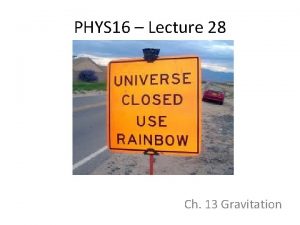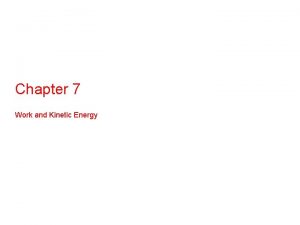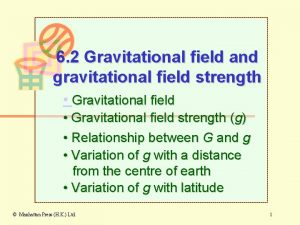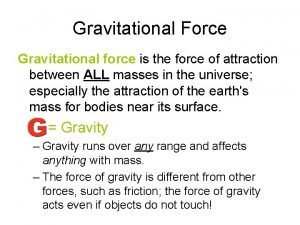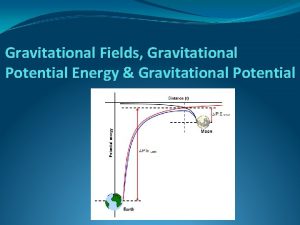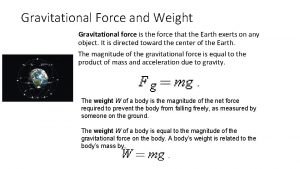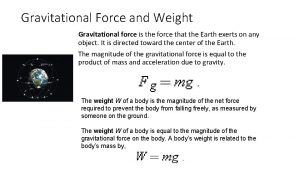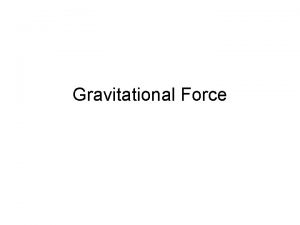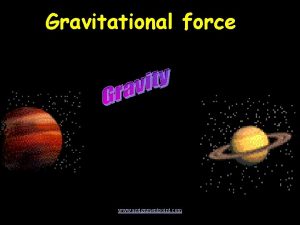Gravitational force Near Earth Gravitational Field Strength copy









- Slides: 9

Gravitational force Near Earth

Gravitational Field Strength (copy) Since the gravitational field strength and the acceleration due to gravity are numerically equal, the same symbol, , is used for both Gravitational Field Strength ( Force ) per unit mass acting on an object in a gravitational field (N/kg) Decreases as altitude increases Varies according to location since Earth is not a perfect sphere On Earth g = 9. 8 N/kg or 9/8 m/s 2

(remember? )

Practice 1. The force of gravity on a 250 kg spacecraft on the moon’s surface is 408 N[down] A) what is the gravitational field strength on the moon? B) what is the acceleration due to gravity of a free-falling object on the surface of the moon? 2. A 50 kg person is standing on a bathroom scale inside an elevator. The scale is calibrated in newton’s. Use a FBD to help find the reading on the scale when the elevator is A) at rest B) moving up at a constant speed C) accelerating up at 2. 2 m/s/s D) accelerating down at 3. 0 m/s/s

The Difference Between Mass & Weight The terms “mass” and “weight” are used interchangeably in everyday language, but these two word have different meanings *copy Mass (m) Weight (Fg) -Quantity of matter in an object (kg) -Constant – only changes if the quantity of matter changes -Measured using a balance -Measure of the force of gravity acting on an object (N) -Varies – depends on the magnitude of g in that location -Measured using a spring scale

Practice 1. An astronaut on the surface of Mars finds that a rock accelerates at a magnitude of 3. 6 m/s 2 when it is dropped. The astronaut also finds that a force scale reads 180 N when the astronaut steps on it. A) what is the astronauts mass as determined on the surface of Mars? B) What should the force scale read if the astronaut stepped on it on Earth?

Copy: Weightlessness or Micro Gravity Terms often used to describe falling objects (and the sensation) Are misleading because gravity is still in effect (needed by objects to keep them in orbit around Earth) A better explanation is “the object is experiencing constant free-fall effect” (i. e. the object is falling towards the Earth’s surface but never reaches it)

Practice 1. A 74 kg astronaut goes up to the ISS on a mission. During his stay, the gravitational field strength on the station is 8. 6 N/Kg A) what is the mass of the astronaut on the station? B) what is the difference between the astronaut’s weight on Earth’s surface and his weight on the station? C) why does the weight of the astronaut change but not his mass when moving from the surface of Earth to the station? Wd D) why does the astronaut appear weitghtless on the staton?

Text Pg. 167, #5, 6, 7, 10
 Newton's law of gravitation
Newton's law of gravitation Centripetal force and gravitational force
Centripetal force and gravitational force Normal force and gravitational force
Normal force and gravitational force Seattle seahawks tackling drills
Seattle seahawks tackling drills Gravitational field ragnarok
Gravitational field ragnarok Gravitational field
Gravitational field Tensile strength and yield strength
Tensile strength and yield strength How to find percentage strength of a solution
How to find percentage strength of a solution Composition of half strength darrow's solution
Composition of half strength darrow's solution Express 5 ppm of iron in water in percentage strength.
Express 5 ppm of iron in water in percentage strength.

